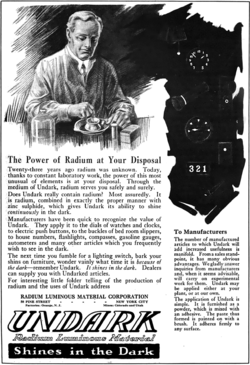Radioluminescence is the phenomenon by which luminescence is produced in a material by the bombardment of ionizing radiation such as beta particles.
Tritium illumination
Tritium is used as a source of beta particles in a large variety of applications where electricity is not available for illumination. For example, gun sights and emergency exit signs.
Radium dials
A 1950s radium clock, exposed to ultraviolet light to increase luminescence
Historically a mixture of radium and copper-doped zinc sulfide was used to paint instrument dials giving a greenish glow. Phosphors containing copper doped zinc sulfide (ZnS:Cu), yielding blue-green light and copper and magnesium doped zinc sulfide (ZnS:Cu,Mg), yielding yellow-orange light are also used. Radium based luminescent paint is no longer used due to the radiation hazard posed to those manufacturing the dials. These phosphors are not suitable for use in layers thicker than 25 mg/cm², as the self-absorption of the light then becomes a problem. Furthermore, zinc sulfide undergoes degradation of its crystal lattice structure, leading to gradual loss of brightness significantly faster than the depletion of radium.
ZnS:Ag coated spinthariscope screens were used by Ernest Rutherford in his experiments discovering atomic nucleus.
Mechanism
Radioluminescence occurs when an incoming radiation particle collides with an atom or molecule, exciting an orbital electron to a higher energy level. The electron then returns to its ground energy level by emitting the extra energy as a photon of light.
Link
Tritium illumination
Tritium is used as a source of beta particles in a large variety of applications where electricity is not available for illumination. For example, gun sights and emergency exit signs.
Radium dials
A 1950s radium clock, exposed to ultraviolet light to increase luminescence
Historically a mixture of radium and copper-doped zinc sulfide was used to paint instrument dials giving a greenish glow. Phosphors containing copper doped zinc sulfide (ZnS:Cu), yielding blue-green light and copper and magnesium doped zinc sulfide (ZnS:Cu,Mg), yielding yellow-orange light are also used. Radium based luminescent paint is no longer used due to the radiation hazard posed to those manufacturing the dials. These phosphors are not suitable for use in layers thicker than 25 mg/cm², as the self-absorption of the light then becomes a problem. Furthermore, zinc sulfide undergoes degradation of its crystal lattice structure, leading to gradual loss of brightness significantly faster than the depletion of radium.
ZnS:Ag coated spinthariscope screens were used by Ernest Rutherford in his experiments discovering atomic nucleus.
Mechanism
Radioluminescence occurs when an incoming radiation particle collides with an atom or molecule, exciting an orbital electron to a higher energy level. The electron then returns to its ground energy level by emitting the extra energy as a photon of light.
Link
